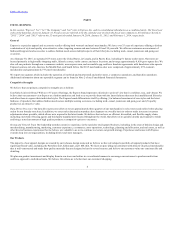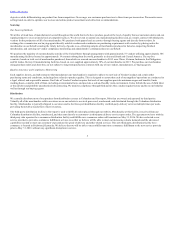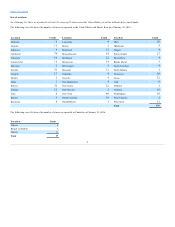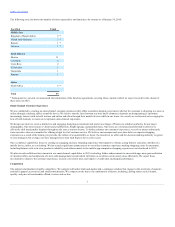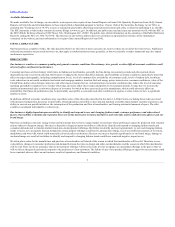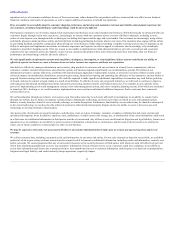Express 2015 Annual Report Download - page 14
Download and view the complete annual report
Please find page 14 of the 2015 Express annual report below. You can navigate through the pages in the report by either clicking on the pages listed below, or by using the keyword search tool below to find specific information within the annual report.
Table of Contents
The success of our growth strategy, including improving the productivity of our existing stores, opening new outlet stores, and growing our e-commerce
business, is dependent on a number of factors and our inability to execute our growth strategy or accomplish our other business objectives could negatively
impact the value of our business.
Our growth strategy is partially dependent on our ability to improve the productivity of our existing stores, open new outlet stores, and grow our e-commerce
business. We are simultaneously pursuing other business objectives, including increasing profitability, supporting and developing our Associates, providing
an exceptional brand and customer experience, and upgrading and enhancing our systems and processes. This will place increased demands on our financial,
operational, managerial, and administrative resources, which could distract our focus and cause business performance to decline. For example, as we look for
ways to expand our product offerings to improve store productivity and grow our e-commerce business, we could lose focus on our existing product offerings,
which could cause a decrease in sales. Many of our objectives, including upgrading our systems, elevating our customer experience, and sharpening our
brand position, require significant financial investments that may not provide a return in the near term or at all.
With respect to our desire to open new outlet stores, we are reliant upon our ability to obtain desirable store locations, negotiating acceptable leases, opening
stores on budget and in a timely manner, supplying merchandise that is differentiated from our retail store merchandise, the continued popularity of outlet
centers, and successfully hiring and training store managers and sales associates. We historically have received landlord allowances related to store build outs
which offset certain capital expenditures we must make to open a new store. If landlord allowances cease to be available to us in the future or are decreased,
opening new stores would require more capital outlay, which could adversely affect our ability to open new stores. Furthermore, to the extent we open new
outlet stores in markets where we have existing stores, our existing stores in those markets may experience reduced net sales.
Executing our growth initiatives and achieving our objectives is dependent upon our ability to successfully execute against such initiatives and objectives.
There can be no guarantee that these initiatives or objectives will result in improved operating results or an increase in the value of the business.
We have, and will continue to have, significant lease obligations. We are subject to risks associated with leasing substantial amounts of space, including
future increases in occupancy costs and the need to generate significant cash flow to meet our lease obligations.
We have, and will continue to have, significant lease obligations. We lease all of our store locations, our corporate offices, and our central distribution
facility. We typically occupy our stores under operating leases with terms of ten years, with options to renew for additional multi-year periods thereafter. In
the future, we may not be able to negotiate favorable lease terms. Our inability to do so may cause our occupancy costs to be higher in future years or may
force us to close stores in desirable locations.
Some of our leases have early cancellation clauses, which permit the lease to be terminated by us or the landlord if certain sales levels are not met in specific
periods or if the center does not meet specified occupancy standards. In addition to future minimum lease payments, some of our store leases provide for
additional rental payments based on a percentage of net sales, or “percentage rent,” if sales at the respective stores exceed specified levels, as well as the
payment of common area maintenance charges, real property insurance, and real estate taxes. Many of our lease agreements have defined escalating rent
provisions over the initial term and any extensions. As we expand our store base, our lease expense and our cash outlays for rent under the lease terms will
increase.
We depend on cash flow from operations to pay our lease expenses. If our business does not generate sufficient cash flow from operating activities to fund
these expenses, due to continued decreases in mall traffic or other factors, we may not be able to service our lease expenses, which could materially harm our
business. Furthermore, the significant cash flow required to satisfy our obligations under the leases increases our vulnerability to adverse changes in general
economic, industry, and competitive conditions, and could limit our ability to fund working capital, incur indebtedness, and make capital expenditures or
other investments in our business.
If an existing or future store is not profitable, and we decide to close it, we may nonetheless be committed to perform our obligations under the applicable
lease including, among other things, paying the base rent for the balance of the lease term. Moreover, even if a lease has an early cancellation clause, we may
not satisfy the contractual requirements for early cancellation under that lease. As of January 30, 2016, our minimum annual rental obligations under long-
term lease arrangements for 2016 and 2017 were $227.8 million and $197.8 million, respectively. Our inability to enter into new leases or renew existing
leases on terms acceptable to us or be released from our obligations under leases for stores that we close could materially adversely affect us.
14


